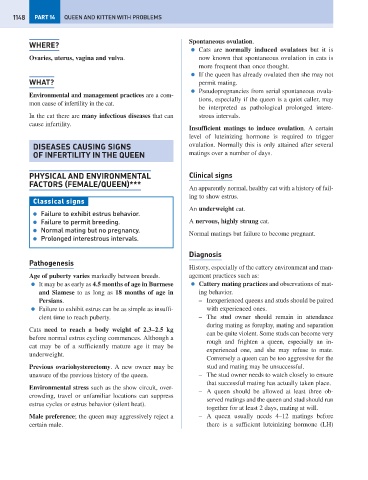Page 1156 - Problem-Based Feline Medicine
P. 1156
1148 PART 14 QUEEN AND KITTEN WITH PROBLEMS
Spontaneous ovulation.
WHERE?
● Cats are normally induced ovulators but it is
Ovaries, uterus, vagina and vulva. now known that spontaneous ovulation in cats is
more frequent than once thought.
● If the queen has already ovulated then she may not
WHAT? permit mating.
● Pseudopregnancies from serial spontaneous ovula-
Environmental and management practices are a com-
tions, especially if the queen is a quiet caller, may
mon cause of infertility in the cat.
be interpreted as pathological prolonged intere-
In the cat there are many infectious diseases that can strous intervals.
cause infertility.
Insufficient matings to induce ovulation. A certain
level of luteinizing hormone is required to trigger
DISEASES CAUSING SIGNS ovulation. Normally this is only attained after several
OF INFERTILITY IN THE QUEEN matings over a number of days.
PHYSICAL AND ENVIRONMENTAL Clinical signs
FACTORS (FEMALE/QUEEN)***
An apparently normal, healthy cat with a history of fail-
ing to show estrus.
Classical signs
An underweight cat.
● Failure to exhibit estrus behavior.
● Failure to permit breeding. A nervous, highly strung cat.
● Normal mating but no pregnancy.
Normal matings but failure to become pregnant.
● Prolonged interestrous intervals.
Diagnosis
Pathogenesis
History, especially of the cattery environment and man-
Age of puberty varies markedly between breeds. agement practices such as:
● It may be as early as 4.5 months of age in Burmese ● Cattery mating practices and observations of mat-
and Siamese to as long as 18 months of age in ing behavior.
Persians. – Inexperienced queens and studs should be paired
● Failure to exhibit estrus can be as simple as insuffi- with experienced ones.
cient time to reach puberty. – The stud owner should remain in attendance
during mating as foreplay, mating and separation
Cats need to reach a body weight of 2.3–2.5 kg
can be quite violent. Some studs can become very
before normal estrus cycling commences. Although a
rough and frighten a queen, especially an in-
cat may be of a sufficiently mature age it may be
experienced one, and she may refuse to mate.
underweight.
Conversely a queen can be too aggressive for the
Previous ovariohysterectomy. A new owner may be stud and mating may be unsuccessful.
unaware of the previous history of the queen. – The stud owner needs to watch closely to ensure
that successful mating has actually taken place.
Environmental stress such as the show circuit, over-
– A queen should be allowed at least three ob-
crowding, travel or unfamiliar locations can suppress
served matings and the queen and stud should run
estrus cycles or estrus behavior (silent heat).
together for at least 2 days, mating at will.
Male preference; the queen may aggressively reject a – A queen usually needs 4–12 matings before
certain male. there is a sufficient luteinizing hormone (LH)

